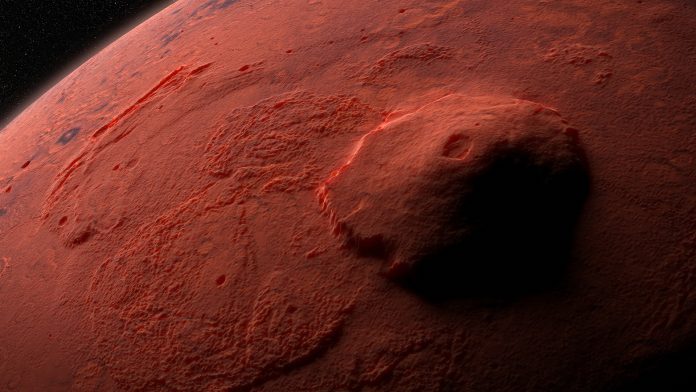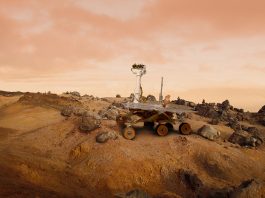In a groundbreaking announcement at the 55th Lunar and Planetary Science Conference held in Texas, scientists revealed the discovery of a giant volcano on Mars.
The giant volcano is located near the planet’s equator in the eastern part of Mars’ Tharsis volcanic province. It was discovered along with a possible sheet of buried glacier ice.
Imaged repeatedly by orbiting spacecraft around Mars since Mariner 9 in 1971 but deeply eroded beyond easy recognition, the giant volcano had been hiding in plain sight for decades in one of Mars’ most iconic regions.
Its discovery points to an exciting new place to search for life and a potential future destination for robotic and human exploration.
How did the researchers stumble upon a giant volcano on Mars?
The volcano’s gigantic size and complex modification history indicate that it has been active for a very long time.
In its southeastern part lies a thin, recent volcanic deposit beneath which glacier ice is likely still present.
“We were examining the geology of an area where we had found the remains of a glacier last year when we realised we were inside a huge and deeply eroded volcano,” said Dr Pascal Lee, a planetary scientist with the SETI Institute and the Mars Institute based at NASA Ames Research Center, and lead author of the study.
The central summit area is marked by several elevated mesas forming an arc, reaching a regional high and sloping downhill away from the summit area.
The gentle outer slopes extend out to 225 kilometres away in different directions.
Sourabh Shubham, a graduate student at the University of Maryland’s Department of Geology and the study’s co-author, explained: “This area of Mars is known to have a wide variety of hydrated minerals spanning a long stretch of Martian history.
“A volcanic setting for these minerals had long been suspected. So, it may not be too surprising to find a giant volcano here.”
A lot of the volcano’s history remains unknown
Much about the newly discovered giant volcano remains a mystery. Although it is clear that it has been active for a long time and began to build up early in Mars’ history, it is unknown how early exactly.
Similarly, although it has experienced eruptions even in modern times, it is unknown if it is still volcanically active and might erupt again.
If it has been active for a very long time, could the combination of sustained warmth and water from ice have allowed the site to harbour life?
As mysteries surrounding the giant volcano on Mars continue to puzzle scientists, the site is already emerging as an exciting new location to study Mars’ geologic evolution, search for life, and plan future robotic and human exploration.
Future human exploration in the region
The possible presence of glacier ice at shallow depths near the equator means that humans could potentially explore a less frigid part of the planet while still being able to extract water for hydration and manufacturing rocket fuel by breaking down H2O into hydrogen and oxygen.
Lee said: “It’s really a combination of things that makes the Noctis volcano site exceptionally exciting. It’s an ancient and long-lived volcano so deeply eroded that you could hike, drive, or fly through it to examine, sample, and date different parts of its interior to study Mars’ evolution through time.
“It has also had a long history of heat interacting with water and ice, which makes the giant volcano a prime location for astrobiology and our search for signs of life.”
He concluded: “Finally, with glacier ice likely still preserved near the surface in a relatively warm equatorial region on Mars, the place is looking very attractive for robotic and human exploration.”









